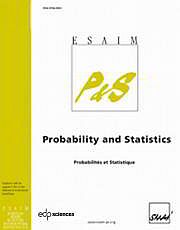Article contents
Spontaneous clustering in theoretical and some empirical stationary processes*
Published online by Cambridge University Press: 29 October 2010
Abstract
In a stationary ergodic process, clustering is defined as the tendency of events to appear in series of increasedfrequency separated by longer breaks. Such behavior, contradicting the theoretical “unbiased behavior” with exponential distribution of the gaps between appearances, is commonly observed in experimental processes and often difficult to explain. In the last section we relate one such empirical example of clustering, in the area of marine technology. In the theoretical part of the paper we prove, using ergodic theory and the notion of category, that clustering (even very strong) is in fact typical for “rare events” defined as long cylinder sets in processes generated by a finite partition of an arbitrary (infinite aperiodic) ergodic measure preserving transformation.
Keywords
Information
- Type
- Research Article
- Information
- Copyright
- © EDP Sciences, SMAI, 2010
Footnotes
This paper was written during the first author’s visit at ISITV in 2007.
References
- 1
- Cited by

